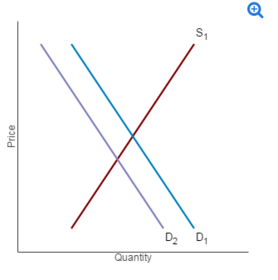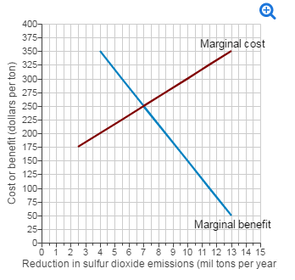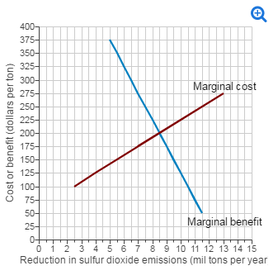Business/Economics Flashcards on Chapter 5 Homework, created by void pickle on 19/10/2016.
Pinned to
15166
2
0
No tags specified
|
|
Created by void pickle
about 8 years ago
|
|
Close
|
|
Created by void pickle
about 8 years ago
|
|

Consider the market illustrated in the figure. Supply curve S1 represents the private cost of production and demand curve D1 represents the private benefit from consumption. Suppose the consumption of this good creates a positive externality. In turn, the social benefit from consumption is represented by demand curve D2. Show how the externality affects market efficiency.

How do externalities affect markets?
If a negative externality in production is present in a market, then
How do externalities in the production of electricity result in market failure?
Because of externalities, the market for electricity will
Externality
Consider the market illustrated in the figure. Supply curve S1 represents the private cost of production and demand curve D1 represents the private benefit of consumption. Suppose consuption of this good creates a positive externality. Show how the externality affects the market.
1) Draw either a new supply or new demand curve incorporating the positive externality in consumption.
2) Indicate the market equilibrium price and quantity.
3) Indicate the effective equilibrium price and quantity.
How do property rights affect externalities and market failure?
Property rights
Suppose the figure to the right illustrates the marginal cost and marginal benefit from reducing sulfur dioxide pollution. Suppose also that the United States is currently planning to eliminate 5.5 million tons of pollution per year.
What would be the net benefit to the United States of instead eliminating 10.0 million tons of sulfur dioxide?
Use the triangle drawing tool to shade in the net benefit to society from eliminating 10.0 million tons of pollution per year compared to eliminating 5.5 million tons of pollution. Label this shaded area 'Net benefit'.
What must be true for the Coase Theorem to hold?
For the Coase Theorem to hold.
The Coase Theorem
Suppose the production of electricity by a utility generates pollution that harms others. Suppose also that Coase bargaining can occur between the utility and the victims of pollution but that the utility has not been legally liable for the damages from its pollution. How would making the utility legally liable for the damages from its pollution affect pollution reduction?
If the electric utility and the people suffering the effects of the utility's pollution can bargain, then making the utility legally liable for the damages from its pollution will
Suppose the figure to the right illustrates the marginal cost and marginal benefit from reducing sulfur dioxide pollution. Suppose also that the United States is currently generating 13.0 million tons of pollution per year.
What is the optimal level of pollution reduction?

How might society solve problems associated with externalities and market failure?
If an externality is present, resulting in market failure, then
Market failure
Transaction costs
Which of the following is an example of transaction cost associated with negotiating the reduction of a negative externality?
An example of a transaction
How might transaction costs affect private solutions to externality problems?
Transaction costs
Suppose the figure illustrates the marginal cost and marginal benefit from reducing sulfur dioxide pollution. How could the government use a command-and-control approach to reduce pollution to the optimal level for society?
The government could

Command-and-control approach
Suppose the government requires each firm to reduce sulfur dioxide emissions by an equal amount such that total emissions are reduced by 8.5 million tons per year. Is this approach necessarily economically efficient?
This command-and-control approach
Suppose the figure to the right illustrates the market for toilet paper, where Upper S 1S1 represents the marginal private cost of production and Upper D 1D1 represents the marginal private benefit from consumption. Companies that produce toilet paper bleach the paper to make it white. Some paper plants discharge the bleach into rivers and lakes, causing substantial environmental damage. Assume that Upper S 2S2 represents the marginal social cost of producing toilet paper (incorporating the externality). What could the government do to internalize the externality?
Pigovian taxes and subsidies
In particular, the government should set a Pigovian tax of $
150 per ton of toilet paper produced.
Cap-and-trade system
Suppose the United States has two utilities, Commonwealth Utilities and Consolidated Electric. Both produce 20 million tons of sulfur dioxide pollution per year. However, the marginal cost of reducing a ton of pollution for Commonwealth Utilities is $400 per ton and the marginal cost of reducing a ton of pollution for Consolidated Electric is $500 per ton. The government's goal is to cut sulfur dioxide pollution in half (by 20 million tons per year).
If the government issues 10 million tradable pollution permits to each utility, what will be the cost of eliminating half of the pollution to society?
If the permits are not tradable, what will be the cost of eliminating half of the pollution?
Companies producing toilet paper bleach the paper to make it white. The bleach is discharged into rivers and lakes and causes substantial environmental damage. The diagram to the right illustrates the situation in the toilet paper market. The private profit minusmaximizing output level is
Companies producing toilet paper bleach the paper to make it white. The bleach is discharged into rivers and lakes and causes substantial environmental damage. The diagram to the right illustrates the situation in the toilet paper market. Suppose the government wants to use a Pigovian tax to bring about the efficient level of production. What should the value of the tax be?
In England during the Middle Ages, each village had an area of pasture, known as a commons, on which any family in the village was allowed to graze its cows or sheep without charge. Was the common land used optimally?
Consider the market illustrated in the figure to the right for fishfish from the oceanthe ocean. Suppose the fishfish are a common resource. Supply curve Upper S 1S1 represents the private cost of production and demand curve Upper D 1D1 represents the private benefit from consumption. Show how the private market overuses common resources.
1.) Use the line drawing tool to first draw either a new supply (Upper S 2S2) or demand (Upper D 2D2) curve showing the true cost of catching fishcatching fish. Properly label this line.
2.) Use the point drawing tool to indicate the actual price and quantity in the private market. Label this point 'Actual equilibrium'.
3.) Use the point drawing tool to indicate the efficient equilibrium price and quantity. Label this point 'Efficient equilibrium'.
A small town provides a fireworks display, which is a public good, every fourth of July. For simplicity, assume the town only has two residents: Hayden and Madison. Their demands for the fireworks display are illustrated in the figure to the right. Construct the market demand curve for this public good.
Use the line drawing tool to draw the market demand curve (DMarket) for the fireworks display. Properly label this line.
Private good
Public good
Quasi-public good
Common resource
Rivalry
Excludability
Consider the consumption of national defense. What type of good is national defense?
National defense is
Consider the consumption of public pasture land. What type of good is public pasture land?
Public pasture land is
Consider the market for a public good such as dams along a river, illustrated in the figure to the right where S 1 represents marginal private costs and D 1 represents marginal private benefits. The dashed green line represents the corresponding marginal social benefit.
Suppose a new recreational neighborhood park would cost $20,000, including opportunity costs, to construct and maintain. If built, the park would be a public good. For simplicity, assume the neighborhood park would be used by three families, each of whom would derive a marginal benefit equivalent to $8,000 from the park.
Should the neighborhood park be built?
If left to the private market, without private bargaining or government intervention, would the park be built?
Suppose a common resource—wood in a public forest—is being overused because residents consider the benefits of gaining firewood or wood for building but do not account for the cost of deforestation when chopping down trees. What could be done to prevent wood in the forest from being overused?
To prevent overuse of the common resource,
Consider a Lacoste shirt. Is the consumption of Lacoste shirts rival and excludable?
The consumption of Lacoste shirts is

 Hide known cards
Hide known cards